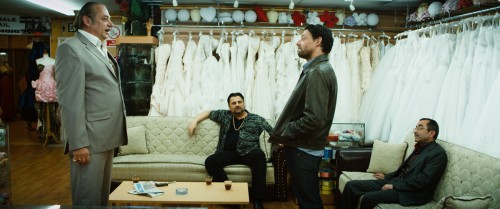 After seeing Pusher, the British remake of G-S-T favorite Nicholas Winding Refn’s 1996 debut feature of the same name, I’m still struggling with questions about the cinematic space it ultimately occupies. None of them, mind you, are germane to discussions of the film’s quality which is respectable, so in the end I’m probably just navel gazing. But the concept of remaking a movie remains contentious even though filmmakers have been remaking movies for decades, so Pusher will inevitably be subjected to value tests based on its recycled nature, which leads me to the good news: Luis Prieto has made a strong, vibrant crime film. The bad news, though, is that what Pusher possesses in energy, it lacks in vitality.
After seeing Pusher, the British remake of G-S-T favorite Nicholas Winding Refn’s 1996 debut feature of the same name, I’m still struggling with questions about the cinematic space it ultimately occupies. None of them, mind you, are germane to discussions of the film’s quality which is respectable, so in the end I’m probably just navel gazing. But the concept of remaking a movie remains contentious even though filmmakers have been remaking movies for decades, so Pusher will inevitably be subjected to value tests based on its recycled nature, which leads me to the good news: Luis Prieto has made a strong, vibrant crime film. The bad news, though, is that what Pusher possesses in energy, it lacks in vitality.
 If you’ve seen Refn’s original picture, you already know the story; Pietro hasn’t done much but streamline the plot and fashioned a leaner interpretation of the Danish talent’s introductory effort. The most obvious difference between the sibling films, in fact, is setting, as Pusher ’12 transplants the story of amiable mid-level drug dealer Frank (Richard Coyle) into the humming cacophony of London. Beyond that, the details vary little and less. At the start of the film, we find Frank in good stead (or what passes for “good stead” for a drug peddler) in his professional and personal life before he runs afoul of the police, courtesy of an anonymous and treacherous tip-off, and a deal goes sour, leaving him deeply in debt to affably-veneered Serbian drug lord Milo (Slavko Labovic, reprising the role he played in Refn’s film). And so begins the very worst week of Frank’s entire life.
If you’ve seen Refn’s original picture, you already know the story; Pietro hasn’t done much but streamline the plot and fashioned a leaner interpretation of the Danish talent’s introductory effort. The most obvious difference between the sibling films, in fact, is setting, as Pusher ’12 transplants the story of amiable mid-level drug dealer Frank (Richard Coyle) into the humming cacophony of London. Beyond that, the details vary little and less. At the start of the film, we find Frank in good stead (or what passes for “good stead” for a drug peddler) in his professional and personal life before he runs afoul of the police, courtesy of an anonymous and treacherous tip-off, and a deal goes sour, leaving him deeply in debt to affably-veneered Serbian drug lord Milo (Slavko Labovic, reprising the role he played in Refn’s film). And so begins the very worst week of Frank’s entire life.
That’s actually not an unfair lens through which to view Pusher: it’s the story of a working man having a terrible, horrible, no-good, very bad week. Of course, Frank’s profession doesn’t really lend itself toward easily resolved tasks, so his version of the Mondays proves far more intolerable than our own. Once his job takes a turn for the worst, his problems begin stacking up exponentially, bit by bit, until Frank– all told a pretty nice guy at first glance– starts to crack and eventually splits asunder in a cascade of brutal violence and unpredictable, manic behavior (which is as much the stress as it is his drug habit) as Pusher nudges Frank into the arms of desperation. Put simply, things get nasty fast.
And through it all we’re mostly sympathetic to Frank. In the grand scheme of things, he remains naught more than a working stiff, and there’s a level of tragedy to the concurrency with which his entire world crumbles around him, slowly leading to the decay of his romantic relationship with his girlfriend, Flo (Agyness Deyn), and his friendship with literal partner-in-crime Tony (Bronson Webb). Even seeing his rapport with Milo fracture feels lamentable; Milo might be a murderous, vicious heroine baron, but he cuts such a charming, gregarious figure that his assumption of Pusher‘s “antagonist” mantle represents almost as great a blow to Frank as the realization that he has been betrayed.

But apart from a wonderful anti-hero in Frank, and a dynamic leading man in Richard Coyle, Pusher has aught else to justify its existence. I don’t know if that necessarily says bad things about the film; Prieto’s craft is solid enough that if Pusher had sprung from his own imagination I’d be praising it as an inventive, vivid, dazzlingly lurid London crime yarn. Then again it may be that good construction and a stylish visual palette is all that’s needed to give the film its reason for being. In fact, I’d be hard pressed to counter any arguments to that effect other than to contextualize Pusher within the framework of the grand remake debate, and therein lies the rub.

The problem with remakes such as Pusher is that inevitably they end up feeling like the original film so much that there’s little reason to pursue them except for completion’s sake. That may read as something of a slight against Prieto’s work here as director, but there’s no genuine , glaring fault to be found in his skill as a technician and storyteller. Truthfully,Pusher‘s Achilles heel manifests itself in the scope of his vision, not in the sense that the film feels small but that it feels content to shoot for the middle; rather than aim higher than Refn’s work, which would admittedly made for quite a lofty target, Prieto chooses to hone in on what’s safer and easier. He doesn’t change the formula other than to trim it and relocate it. He doesn’t say anything new about Frank’s plight, and instead simply filters it through the facade of another actor.
G-S-T RULING:
So Pusher becomes an exercise in repetition. It helps that Prieto doesn’t actively try to ape Refn’s style and at least gives his film its own visual signature, but one wonders why he didn’t use the original movie’s skeleton to explore anything new or specific to his characters and his geography. Maybe the greater point being made here is that there’s nothing culturally unique about Frank’s story; whether in London or Copenhagen, a pusher is a pusher, and they’re liable to meet the same dooms no matter how hard they fight to avoid them. If that’s the case, then Prieto’s Pusher should be seen as a success of sameness. This is not a Snatch, where fate kindly intervenes in the most convenient of ways; this is a Layer Cake, a film where the hero cannot outwit fate. But that’s precisely the sort of film Refn made sixteen years ago, too, and if Prieto is guilty of anything it’s repackaging Pusher with roughly the same content.


